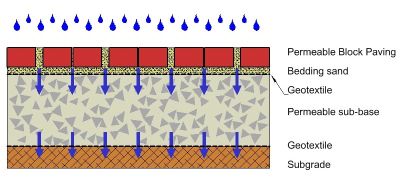- Paving
- Electrical Engineering and Telecoms Infrastructure
- Civil Engineering, Mining, Railway, Building and Plumbing Products
- Curbs / Kerbs
- Landscaping, Streetscaping, Gardening products
- Moulds
- Pizza Oven Kit
- Avalon range
- Builders' and Plumbers' Products
- Benches and Seats
- Concrete Tables
- Grass Blocks
- Litter/Refuse Bins
- Pots and planters (Discontinued)
- Tree rings
- Bollards and Barriers
- Stone Cellar Blocks
- Water features (Discontinued)
Stormwater Management by Permeable Concrete Block Paving
Permeable paving or Permeable Concrete Block Paving (PCBP) is not simply a standard road foundation with permeable paving on top. It is a design philosophy which, when using a range of techniques in sequence, is known as a management train. PCBP manages surface water by attenuation and filtration with the aim of replicating, as closely as possible, the natural drainage from the site before development (ref 2). The two basic components of PCBP are porous paving blocks and a porous road foundation.
In the design philosophy PCBP is used in the place of elaborate stormwater systems including catchpits, massive pipes, canals and outlet structures. All or part of the surface is made permeable, and the water is allowed to infiltrate. While collecting under the surface it absorbs the flood, infiltrates the ground and the (much reduced) excess is drained away.
Three broad systems depending on ground conditions can be identified (ref 2):
System A – Full Infiltration
Suitable for a subgrade with good permeability. This system allows all the water falling onto the pavement to infiltrate through the constructed layers. Some temporary water retention may occur but no water is discarded into a drainage system. This system is particularly economical.

System B – Partial Infiltration
Used where the subgrade is not able to absorb all the water. A fixed amount of water is allowed to infiltrate – which often represents a large percentage of the rainfall. Outlet pipes are connected to the permeable sub-base, which allow excess water to be drained to other devices such as swales, ponds, watercourses or sewers.

System C – No Infiltration
Applicable where the existing subgrade permeability is poor or contains pollutants. System C allows for the complete capture of the water. By isolating the porous sub-base from the surrounding subgrage by means of a flexible membrane it acts as a storage tank. Outlet pipes are connected through the membrane to transmit the water as is appropriate.
The advantages of this system are: 1) attenuation and much smaller drainage pipes and 2) isolation where there is risk of contamination. In the arid parts of Australia, a similar system is used for collecting and storing rainwater. It is then used locally for irrigation or in water features.

